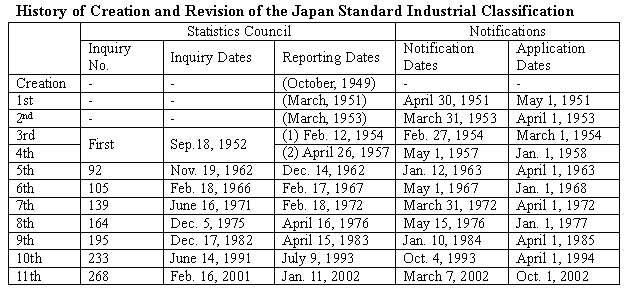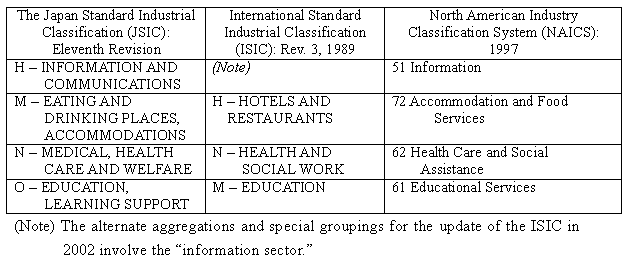The Japan Standard Industrial Classification is a set of statistical standards used to show statistical survey results by industry, which classifies all economic activities involving the production and provision of goods and services performed at business establishments in the form of a social division of labor. The Standard Industrial Classification was created in October 1949 to ensure the accuracy and objectivity of statistics, and to make it easier to compare statistics and obtain maximum benefit from them.
This eleventh revision of the Japan Standard Industrial Classification (as revised in March 2002) is the product of an extensive review in an attempt to adapt the Classification to the structural changes that have taken place in industry since the tenth revision in October 1993, in particular changes such as the advancement of telecommunications, the growth of software- and service- oriented economic activities, and the transition of Japan to an aging society with a declining birthrate. The current revision is the eleventh since the Classification was first devised in October 1949.
The following provides some historical background up to institution of the Japan Standard Industrial Classification (hereafter referred to as the "JSIC") in October 1949, and until the tenth revision in October 1993.
The first industrial classification in Japan was compiled in 1930, for the third Population Census. Prior to this, an occupational classification was drawn up in 1920 when the first Population Census was taken. This however combined industry and occupation. It would be reasonable to say therefore that 1930 saw these two types of classification separated distinctly for the first time. Cabinet Instruction No. 3 stipulated that all relevant ministries use the same industrial classification; this however failed to fully achieve the intended result.
Thereafter, along with the development of economic statistics, industrial classifications began to be compiled - albeit still partial in scope, for example manufacturing sector and agricultural sector classifications. However a lack of uniformity in the criteria used for classification, and discrepancies in interpretation caused much inconvenience in the application of these classifications. For example, certain business establishments surveyed would sometimes be classified in irrelevant industries. As a result, by the fifth Population Census in 1940, drawing up a standard industrial classification for Japan had become a pressing issue. A uniform classification was consequently created through cooperation among experts from the relevant ministries and agencies, and the common use of this industrial classification encouraged under an agreement among administrative vice-ministers of the relevant ministries.
At this time however, due to the lack of a proper logical system for administrative instructions on details of the classification and for definitions of its general principles, the intended uniformity remained no more than a formality, and a great deal of numerical variance was found in the survey results. The need for a logically consistent standard industrial classification was pressing.
After the war, when Japan was due to conduct various types of large-scale census in conjunction with the 1950 World Census promoted by the United Nations, a Central Planning Commission for the 1950 Census was established under the Statistics Commission, and various special sub-committees formed in a bid to promote both research on the conduct of censuses and, as a further fundamental undertaking, research for various types of classification.
The Industrial Classification Special Sub-committee, one of these special sub-committees, commenced the task of creating a standard industrial classification in March 1949, and the JSIC based on decimal classification was completed in October of the same year. Since then, it has been used in many important statistical surveys including designated statistics.
The twelfth Statistics Commission and the seventeenth Statistics Commission deliberated on the issue of unified use of the JSIC on December 23, 1949 and April 28, 1950 respectively. As a result, a cabinet order was instituted based on the Statistics Law.
At the time of this cabinet order making the unified use of the JSIC compulsory, a prime consideration was the extent to which the JSIC could reasonably be applied to numerous statistical surveys. Consequently, following a review of the results of actual use of the JSIC since its creation in 1949, as well as the transformation in the industrial structure of Japan, the need to revise this standard classification was recognized. Each working group, created by industrial sector under the Industrial Classification Special Sub-committee, undertook the task of revising the Classification, and a definite plan was formulated in March 1951. Cabinet Order No. 127- April 30, 1951 entitled "Cabinet Order for Creating an Industrial Classification and Classification of Diseases, Injuries and Causes of Death to be Used for Statistical Surveys" was then issued and the first revision of the JSIC completed at the same time.
Thereafter, changes such as the transformation of Japanese industry prompted a further need to adapt this Classification to the actual situation in Japan, and the second revision was carried out in March 1953, followed by the third in February 1954, which created a new category, i.e. "Manufacture of ordnance and accessories."
During this period, the Statistics Commission was integrated into the Administrative Management Agency under the reformation of government administration implemented in August 1952. As a result, the Industrial Classification Special Sub-committee under the Statistics Council attached to the Administrative Management Agency was assigned responsibility for deliberating on issues related to the JSIC. The third revision mentioned above derived from the first Report to Inquiry No. 1 (Re: "Setting Standards of Industrial Classification to be Used for Statistical Surveys), given to the Chairman of the Statistics Council by the Director-General of the Administrative Management Agency at the first Statistics Council held on September 18, 1952.
Reflecting diverse changes in the industrial structure of Japan, multiple problems continued to occur in the application of the JSIC to various types of statistical surveys. This led to a series of revisions over the years, including the fourth revision in May 1957, fifth in January 1963, sixth in May 1967, seventh in March 1972, eighth in May 1976, ninth in January 1984, and tenth in October 1993.
The fourth revision was based on the second Report to Inquiry No.1. Each of the subsequent revisions however was carried out in response to each renewed inquiry to the Statistics Council concerning revisions. The following table lists reference Inquiry Numbers, dates for Inquiries and Reports, and dates of Notifications based on Cabinet Orders and their applications related to the creation and revision of the Classification.

Top of this chapter
(3)Major points revised
The following is a summary of the revisions.
A.Basic perspective for revisions
(a)Adaptation to transformation of the industrial structure caused by the advancement of telecommunications, development of a service-oriented economy and the like,
(b) Establishment of appropriate classification items having distinct concepts and definitions, taking into account the need to maintain the continuity of statistics, and
(c) Improvement in comparability with international industrial classifications such as the International Standard Industrial Classification (ISIC).
B.Additions and reductions in classification items by revision

C.Major points of revisions
New divisions were established, the first since the fourth revision (May 1957). An overall review of classification items in major group, group and industry was also conducted to adapt the JSIC to changes in the industrial structure.
(a)Establishment of new divisions
* "INFORMATION AND COMMUNICATIONS"
In light of technological innovation and development in the fields of telecommunications and information processing, a new division has been established, comprising five major groups including "Communications," "Information Services," and " Internet Based Services."
* "MEDICAL, HEALTH CARE AND WELFARE," and "EDUCATION, LEARNING SUPPORT"
The division "L - SERVICE" accounts for around a quarter of all industries in terms of numbers of both establishments and employees, and involves a diverse mix of economic activities. Therefore the following changes have been made in order to clarify the actual state of these industries:
- Fields relevant to medical, health care and welfare are expanding in scale along with the advent and diversification of new industries involved in nursing care. A new division has therefore been established by separating these fields from the division "L - SERVICES."
- Fields relevant to education and learning support services are expanding in scale along with the increase in learning opportunities, lifelong learning and leisure time. A new division has therefore been established by separating these fields from the division "L - SERVICES."
* "EATING AND DRINKING PLACES, ACCOMMODATIONS"
In the division "I - WHOLESALE AND RETAIL TRADE, EATING AND DRINKING PLACES," the service aspect of eating and drinking places (food and beverage establishments) is growing, and an increasing proportion of revenues in the major group "Hotels, Boarding Houses and Other Lodging Places" under the division "L - SERVICES" is derived from providing food and beverages. These services have therefore been separated from their current divisions and classified in a new division to be established.
* "COMPOUND SERVICES"
"Postal Services" in the major group under the division "H - TRANSPORT AND COMMUNICATION," and "Cooperative Associations" in the major group under the division "L - SERVICES" are performing multiple types of service across plural divisions, making it difficult to ascertain their actual situation and identify their major businesses. These have therefore been separated from the divisions to which they belong and a new division established for them.
 New divisions will improve comparability with international industrial classifications.
New divisions will improve comparability with international industrial classifications.
(b)Reviewing major group items (22 new items; 24 items to be abolished)
* New major group items
i) "Manufacture of Information and Communication Electronics Equipment" and "Electronic Parts and Devices":
Along with the advancement of information technologies and expansion of the associated industries, these have been removed from the major group "Manufacture of Electrical Machinery, Equipment and Supplies" under the division "F - MANUFACTURING" and a new major group established for them.
ii) "Internet Based Services":
This new major group has been established under the division "H - INFORMATION AND COMMUNICATIONS" as a category for industries in an intermediate position between the two industries of "Communications" and "Information Services," and difficult to classify under either.
* Abolition
i) "Metal Mining," etc.:
This has been changed to a major group "Mining," by abolishing "Metal Mining," "Coal and Lignite Mining," "Crude Petroleum and Natural Gas Production," and "Non-metallic Mineral Mining," all of which were in the major groups under the division "D - MINING."
ii) "Manufacture of Ordnance and Accessories":
The major group "Manufacture of Ordnance and Accessories" under the division "F - MANUFACTURING," has been abolished and positioned as a group item under the major group "Miscellaneous Manufacturing Industries."
iii) "Financial Institutions for Small Business, except Government Related Financial Institutions" and "Financial Institutions for Agriculture, Forestry and Fisheries Finances, except Government Related Financial Institutions":
The major group items "Financial Institutions for Small Business, except Government Related Financial Institutions" and "Financial Institutions for Agriculture, Forestry and Fisheries Finances, except Government Related Financial Institutions," both under the division "J - FINANCE and INSURANCE" have been abolished and now come under a new major group "Financial Institutions for Cooperative Organizations."
(c) Review of group items and industry items
* Group items (76 new items; 119 for abolition)
i) New items
"Building Reform (or renovation) Work," "Flooring and Interior Finishing Work," "Industrial Trucks and Parts and Accessories," "Mobile Telecommunications," "Supplementary Tutorial Schools," "Instruction Services for Arts, Culture and Technical Skills," etc.
ii) Items to be abolished
"Sericulture Farms," "Precious Metallic Ore Mining," "Crude Petroleum (Production)," "Roofing Work," "Briquettes and Briquette Balls," "Agents and Brokers," "Foreign Banks in Japan," "Fulling and Dyeing Plants," etc.
* Industry items(162 new items; 215 for abolition)
i) New items
"Amusement machines manufacture," "Personal computer," "Satellite broadcasting," "Convenience stores (sales of staple food and beverages only)," "Pet stores," "Home care help services," "Special nursing home for the elderly," "Secondary schools," "Foreign language instructions," "Aesthetic salon service (or beauty treatment services)," "Game centers" etc.
ii) Items to be abolished
"Copper ore (Mining)," "Pump-well work," "Agar-agar and isinglass," "Spinning mills, silk staple," "(Manufacture of) Wooden shavings and chips," "Wooden footwear," "Saddlery and whips," "Mini-sized vehicle passenger transport," "Explosives (Wholesale Trade)," "Coal (Wholesale Trade)," "Cotton beating services" etc.
Top of this chapter



 New divisions will improve comparability with international industrial classifications.
New divisions will improve comparability with international industrial classifications.